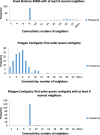Geospatial patterns of comorbidity prevalence among people with osteoarthritis in Alberta Canada
- PMID: 33059639
- PMCID: PMC7559790
- DOI: 10.1186/s12889-020-09599-0
Geospatial patterns of comorbidity prevalence among people with osteoarthritis in Alberta Canada
Abstract
Background: Knowledge of geospatial pattern in comorbidities prevalence is critical to an understanding of the local health needs among people with osteoarthritis (OA). It provides valuable information for targeting optimal OA treatment and management at the local level. However, there is, at present, limited evidence about the geospatial pattern of comorbidity prevalence in Alberta, Canada.
Methods: Five administrative health datasets were linked to identify OA cases and comorbidities using validated case definitions. We explored the geospatial pattern in comorbidity prevalence at two standard geographic areas levels defined by the Alberta Health Services: descriptive analysis at rural-urban continuum level; spatial analysis (global Moran's I, hot spot analysis, cluster and outlier analysis) at the local geographic area (LGA) level. We compared area-level indicators in comorbidities hotspots to those in the rest of Alberta (non-hotspots).
Results: Among 359,638 OA cases in 2013, approximately 60% of people resided in Metro and Urban areas, compared to 2% in Rural Remote areas. All comorbidity groups exhibited statistically significant spatial autocorrelation (hypertension: Moran's I index 0.24, z score 4.61). Comorbidity hotspots, except depression, were located primarily in Rural and Rural Remote areas. Depression was more prevalent in Metro (Edmonton-Abbottsfield: 194 cases per 1000 population, 95%CI 192-195) and Urban LGAs (Lethbridge-North: 169, 95%CI 168-171) compared to Rural areas (Fox Creek: 65, 95%CI 63-68). Comorbidities hotspots included a higher percentage of First Nations or Inuit people. People with OA living in hotspots had lower socioeconomic status and less access to care compared to non-hotspots.
Conclusions: The findings highlight notable rural-urban disparities in comorbidities prevalence among people with OA in Alberta, Canada. Our study provides valuable evidence for policy and decision makers to design programs that ensure patients with OA receive optimal health management tailored to their local needs and a reduction in current OA health disparities.
Keywords: Comorbidity; Disparities; Osteoarthritis; Rural; Spatial analysis.
Conflict of interest statement
The authors declare that they have no competing interests.
Figures





Similar articles
-
Rural-Urban Disparities in Realized Spatial Access to General Practitioners, Orthopedic Surgeons, and Physiotherapists among People with Osteoarthritis in Alberta, Canada.Int J Environ Res Public Health. 2022 Jun 23;19(13):7706. doi: 10.3390/ijerph19137706. Int J Environ Res Public Health. 2022. PMID: 35805363 Free PMC article.
-
Existing comorbidities in people with osteoarthritis: a retrospective analysis of a population-based cohort in Alberta, Canada.BMJ Open. 2019 Nov 21;9(11):e033334. doi: 10.1136/bmjopen-2019-033334. BMJ Open. 2019. PMID: 31753902 Free PMC article.
-
Geographic Variation in the Prevalence of Rheumatoid Arthritis in Alberta, Canada.ACR Open Rheumatol. 2021 May;3(5):324-332. doi: 10.1002/acr2.11251. Epub 2021 Apr 1. ACR Open Rheumatol. 2021. PMID: 33793090 Free PMC article.
-
Farming and the risk of developing osteoarthritis in Alberta, Canada.Rural Remote Health. 2024 May;24(2):8383. doi: 10.22605/RRH8383. Epub 2024 May 24. Rural Remote Health. 2024. PMID: 38826129
-
Comorbidities in Osteoarthritis: A Systematic Review and Meta-Analysis of Observational Studies.Arthritis Care Res (Hoboken). 2020 Jul;72(7):991-1000. doi: 10.1002/acr.24008. Epub 2020 Jun 7. Arthritis Care Res (Hoboken). 2020. PMID: 31207113
Cited by
-
Rural-Urban Disparities in Realized Spatial Access to General Practitioners, Orthopedic Surgeons, and Physiotherapists among People with Osteoarthritis in Alberta, Canada.Int J Environ Res Public Health. 2022 Jun 23;19(13):7706. doi: 10.3390/ijerph19137706. Int J Environ Res Public Health. 2022. PMID: 35805363 Free PMC article.
-
Geography as a Determinant of Health: Health Services Utilization of Pediatric Respiratory Illness in a Canadian Province.Int J Environ Res Public Health. 2021 Aug 6;18(16):8347. doi: 10.3390/ijerph18168347. Int J Environ Res Public Health. 2021. PMID: 34444093 Free PMC article.
-
Geospatial analysis and participant characteristics associated with colorectal cancer screening participation in Alberta, Canada: a population-based cross-sectional study.BMC Health Serv Res. 2023 Dec 21;23(1):1454. doi: 10.1186/s12913-023-10486-8. BMC Health Serv Res. 2023. PMID: 38129826 Free PMC article.
-
Individual and Geospatial Determinants of Health Associated With School-Based Human Papillomavirus Immunization in Alberta: Population-Based Cohort Study.JMIR Public Health Surveill. 2024 Mar 27;10:e45508. doi: 10.2196/45508. JMIR Public Health Surveill. 2024. PMID: 38536211 Free PMC article.
-
Rural-Urban Differences in Non-Local Primary Care Utilization among People with Osteoarthritis: The Role of Area-Level Factors.Int J Environ Res Public Health. 2022 May 24;19(11):6392. doi: 10.3390/ijerph19116392. Int J Environ Res Public Health. 2022. PMID: 35681975 Free PMC article.
References
-
- Birtwhistle R, Morkem R, Peat G, Williamson T, Green ME, Khan S, et al. Prevalence and management of osteoarthritis in primary care: an epidemiologic cohort study from the Canadian primary care sentinel surveillance network. C Open. 2015;3:E270–E275. doi: 10.9778/cmajo.20150018. - DOI - PMC - PubMed
-
- Bombardier C, Hawker G, Mosher D. The impact of arthritis in Canada: today and over the next 30 years. 2011.
MeSH terms
Grants and funding
LinkOut - more resources
Full Text Sources
Medical

